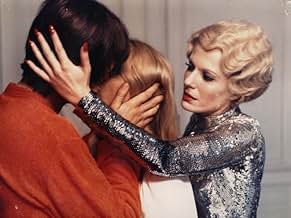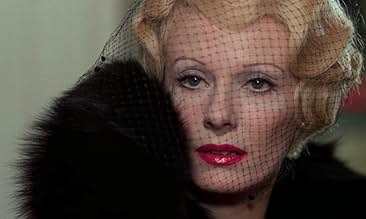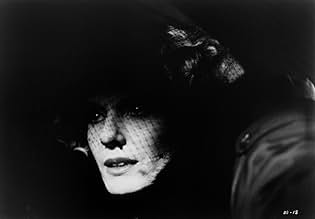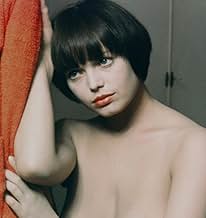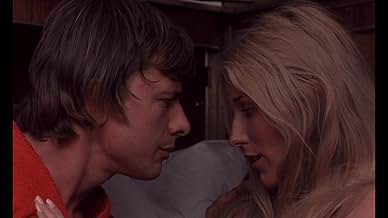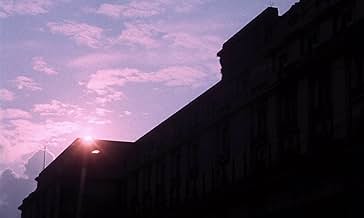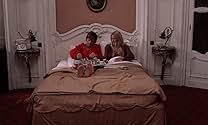VALUTAZIONE IMDb
6,5/10
7577
LA TUA VALUTAZIONE
Una coppia di sposi sta attraversando un villaggio vacanze. I loro percorsi si incrociano con una misteriosa contessa straordinariamente bella e la sua aiutante.Una coppia di sposi sta attraversando un villaggio vacanze. I loro percorsi si incrociano con una misteriosa contessa straordinariamente bella e la sua aiutante.Una coppia di sposi sta attraversando un villaggio vacanze. I loro percorsi si incrociano con una misteriosa contessa straordinariamente bella e la sua aiutante.
- Regia
- Sceneggiatura
- Star
Recensioni in evidenza
Stay with this film, it is incredible. Great acting, cinematography, direction. The lead actress isn't great, but the actress who plays Erzebet Bathory is phenomenal. Bizaar sets, and strange milieu really add to this film's strange portrayal of vampires and how they deal with the living. I really loved this film. Of course, today, everything happens at the speed of light. Back in 1970, they took their time with building the film and really letting it sink in before hitting you with the shocks. This one has plenty of shocking moments and some really great inventive scenes that add to the history of the vampire film. Unfortunately, today we now have 'Twilight', a disgusting parody of the genre that hopefully audiences will someday say, 'What the hell were we thinking?'.
While I appreciate vampires as a staple of the horror genre, I have never been a big fan of vampire films. And while I will be the first to laud the merits of Bela Lugosi and Christopher Lee's contributions to the cape, they look rather timid next to Countess Elizabeth Bathory (the luminous and sensual Delphine Seyrig) in "Daughters of Darkness." While Harry Kumel's film is one of the most aesthetically beautiful vampire pictures ever lensed, dripping with subtle sexual tension, it also presses forth with a feminist/lesbian subtext that's as alluring as it is clever. The plot is relatively straightforward, and the film takes its time in establishing mood and atmosphere--Valerie (Danielle Ouiment) and Stefan (John Karlen) are newlyweds who are on the rocks only 3 hours into the marriage, and things are complicated further when Countess Bathory and her assistant, Ilona (Andrea Rau) check into the same deserted seaside hotel. While the atmosphere could be compared to the Universal and Hammer horrors, Kumel's artistry--with well-framed images, emphasis on wardrobe, and a very deliberate color scheme--exists in its own unique league. The topic of lesbianism--and even heterosexuality--is presented in a minimalist, unexploitative manner, yet maintains a pervasive eroticism throughout. Even the vampiric seduction is presented with a minimum of graphic bloodshed, which is all the more effective. "Daughters of Darkness" is the type of moody, character-driven piece that plays like a sensual sister to George Romero's similarly unique "Martin." As my comment title implies, this is an excellent film, required viewing for fans of horror and great art alike.
A contained, haunting tale of vampirism, with ties to the infamous Elizabeth Bathory, this film drips with artistic merit. From the picturesque shots to the red fades to the stinger notes, it's easy to appreciate this production. The delicate, deliberate pace may turn off some viewers but the dream-like atmosphere easily held my attention, not to mention the three beautiful female leads. The bizarre ending (before the epilogue) was unexpected and indeed provided a wonderfully macabre and memorable image. Daughters of Darkness succeeds at what Vampyros Lesbos attempted to be. Just make sure to watch the full version.
Finally it became available, the director's cut of this 40 year old vampire flick. The weirdness is that it doesn't contain real vampires like you know them. You never see any fangs but it's the atmosphere that keep you attracted to the teevee. The other part that is funny for me is that all the places shown I have seen them, easily to explain, I grow up in Ostend in the seventies. But what an excellent flick this is, even without the gore and almost without th red stuff. There is a lot of nudity but it never becomes gratuitous. It is also strange that a Flemish director (Harry Kumel) was able to get big names, Delphine Seyrig was an icon at that time and even the others were well known then. The quality available on the Blue Underground DVD is excellent, even the sound is great, no hiss or whatsoever. It is a beauty to see and remembering that it was made without a big budget. It is indeed as stated on the sleeve erotic and unusual.
Beware as you go into this, it may sound like Hammer but it's nothing like it. It's a chic, stylish vampire film dripping with the most wanton aestheticism. The whole thing exudes the scent of an absinthe dream, the contours of a flowing red dress.
Superficially it is about a couple of newly-weds - but who, as the film opens with them having sex in a train cabin, openly declare that they don't love each other - who find themselves stranded in Ostande and move in to a strangely empty hotel for a few days. A countess Bathory arrives there with her female companion, there's also the baffled concierge who tries to stay out of passion's way.
I say superficially because the dynamics between the couple is what at first sight seems to be driving the story. The woman is desperate to break out from the limbo of anonymous sex and be introduced, thus be legitimized as a wife and woman, to the man's mother, an aristocrat back in England. The man, on the other hand, is content to derail those expectations and savour the erotic dream he has concocted to inhabit.
But of course we come to understand that the narrative is powered from outside. The countess courts both, seducing in the emotional space between them. She personifies that wanton aestheticism right down to her body language. It is important to note that she is played by the actress who starred in Marienbad for Resnais, which this film alludes to; in the mysterious hotel setting with its expansive balustrades, in the twilight wanderings, in the sense of time revoked and sensations amplified.
She is the architect of all this, building around these people the desires that will yield them to her. So it is the man's semi-conscious world of secret pleasures, but it's she who is slowly, slyly perverting them. She does this with the malevolent purity of a femme fatale.
It does not matter that she is Bathory, or that blood is eventually savored from wrists, this is merely the desire made visible in a way that would appeal to a niche audience. So even though Jess Franco borrowed the velvety sunsets and decadent air from this for Vampyros Lesbos, this operates deeper. It matters for example that she seduces the man into a new obsession with violence, the destructive flipside of eros. It further pries the woman apart from him.
Gradually what was a matter of taking pleasure from flesh is spun into something else entirely; again involving flesh but now literally draining from his.
It ends with a stunning sequence across countryside roads; a lot of the imagery recalls L'Herbier - who also inspired Resnais - but here more pertinently. The soul has been so withered away from inside, so consumed from the fever of passion, that mere sunlight sends it reeling. Of course we can explain away by falling back to our knowledge of vampire lore, but we'd be missing on the finer abstractions; how, for example, the femme fatale is magically cast into the circumstances that, as we know from our knowledge of this type of film, would precipitate her demise. Nothing else would do after all.
If we follow the set of reactions from what at first sight appears like an accident, it can be plainly seen how it all flows from her desire to control the narrative.
It's marvelous stuff just the same, the colors, the desolate aura. I just want to urge you to see as more than just an 'artsy vampire flick'. Save that for Jean Rollin.
Superficially it is about a couple of newly-weds - but who, as the film opens with them having sex in a train cabin, openly declare that they don't love each other - who find themselves stranded in Ostande and move in to a strangely empty hotel for a few days. A countess Bathory arrives there with her female companion, there's also the baffled concierge who tries to stay out of passion's way.
I say superficially because the dynamics between the couple is what at first sight seems to be driving the story. The woman is desperate to break out from the limbo of anonymous sex and be introduced, thus be legitimized as a wife and woman, to the man's mother, an aristocrat back in England. The man, on the other hand, is content to derail those expectations and savour the erotic dream he has concocted to inhabit.
But of course we come to understand that the narrative is powered from outside. The countess courts both, seducing in the emotional space between them. She personifies that wanton aestheticism right down to her body language. It is important to note that she is played by the actress who starred in Marienbad for Resnais, which this film alludes to; in the mysterious hotel setting with its expansive balustrades, in the twilight wanderings, in the sense of time revoked and sensations amplified.
She is the architect of all this, building around these people the desires that will yield them to her. So it is the man's semi-conscious world of secret pleasures, but it's she who is slowly, slyly perverting them. She does this with the malevolent purity of a femme fatale.
It does not matter that she is Bathory, or that blood is eventually savored from wrists, this is merely the desire made visible in a way that would appeal to a niche audience. So even though Jess Franco borrowed the velvety sunsets and decadent air from this for Vampyros Lesbos, this operates deeper. It matters for example that she seduces the man into a new obsession with violence, the destructive flipside of eros. It further pries the woman apart from him.
Gradually what was a matter of taking pleasure from flesh is spun into something else entirely; again involving flesh but now literally draining from his.
It ends with a stunning sequence across countryside roads; a lot of the imagery recalls L'Herbier - who also inspired Resnais - but here more pertinently. The soul has been so withered away from inside, so consumed from the fever of passion, that mere sunlight sends it reeling. Of course we can explain away by falling back to our knowledge of vampire lore, but we'd be missing on the finer abstractions; how, for example, the femme fatale is magically cast into the circumstances that, as we know from our knowledge of this type of film, would precipitate her demise. Nothing else would do after all.
If we follow the set of reactions from what at first sight appears like an accident, it can be plainly seen how it all flows from her desire to control the narrative.
It's marvelous stuff just the same, the colors, the desolate aura. I just want to urge you to see as more than just an 'artsy vampire flick'. Save that for Jean Rollin.
Lo sapevi?
- QuizDuring filming, director Harry Kümel hit actress Danielle Ouimet during a dispute. Actor John Karlen was so infuriated by this behavior that he punched Kumel in the face. The atmosphere on the set was understandably tense afterwards.
- BlooperWhen Ilona is lying on the bathroom floor, bikini marks are visible. Vampires are not supposed to have tan lines.
- Citazioni
Countess Bathory: Love is stronger than death... even than life.
- Versioni alternativeThe original U.S. theatrical release was cut by approximately 12 minutes to obtain an R-rating, and features a slightly different opening credits sequence in which Lainie Cooke (not Delphine Seyrig as sometimes rumored) sings over the main theme of the film. This sequence features a stylized title logo (the same as that on the U.S. posters), while the rest of the credits use a font that is more formal and less bold compared to the original version. After being released on Canadian and American VHS (where it was retitled "Children of the Night"), the U.S. version was eventually replaced in circulation by the uncut version in the 1990s, although its title sequence is presented among the special features of Blue Underground's 2020 4K Blu-ray release of the film.
- ConnessioniEdited into Rob Zombie: Living Dead Girl (1999)
- Colonne sonoreDaughters of Darkness
Written and Performed by François de Roubaix
Sung by Lainie Cooke
Lyrics by Terence Stockdale
I più visti
Accedi per valutare e creare un elenco di titoli salvati per ottenere consigli personalizzati
- How long is Daughters of Darkness?Powered by Alexa
Dettagli
- Data di uscita
- Paesi di origine
- Lingue
- Celebre anche come
- Daughters of Darkness
- Luoghi delle riprese
- Aziende produttrici
- Vedi altri crediti dell’azienda su IMDbPro
Botteghino
- Budget
- 750.000 USD (previsto)
- Lordo in tutto il mondo
- 1070 USD
- Tempo di esecuzione1 ora 27 minuti
- Mix di suoni
- Proporzioni
- 1.66 : 1
Contribuisci a questa pagina
Suggerisci una modifica o aggiungi i contenuti mancanti

Divario superiore
By what name was La vestale di Satana (1971) officially released in India in English?
Rispondi

